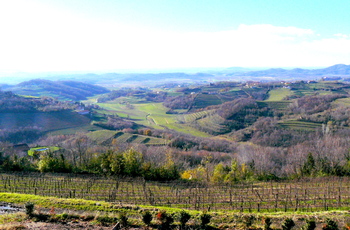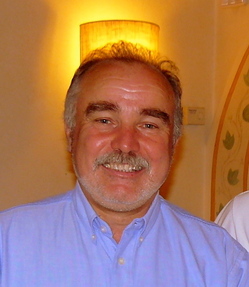
FRIULI, Italy--It hasn't been tried before, an international summit like this on the opportunities and challenges facing the country's
best white wines. We're not talking about the bulk pinot grigio, you understand, but the most prestigious wines from this region in the northeast corner of Italy, on the border with Slovenia). The daylong conference was organized by the
Collio wine producers, and drew a good crowd of local winemakers, consultants, marketers, importers, exporters and restaurateurs, along with a dozen or more journalists. The panels--once the public and industry officials made the obligatory welcome speeches--talked about technical issues in the morning and marketing in the afternoon.
The challenge was expressed by a grower who didn't attend. Edi Keber, whom I called the "Commoner-King of Collio" in a
post last year, looked out from his winery this morning and surveyed the landscape, where vineyards and whitewashed houses share the sun-drenched hills, where Italy blends into Slovenia without so much as a border fence. "I could make and sell 50,000 bottles of pinot grigio here, but I would betray my heritage. What grows here is unique. Several varieties, but one wine." It's as if the very blend were a single grape variety. Nobody much cares that Bordeaux grows half a dozen red grapes, Keber points out. The same here. "One wine, and it is virtually autochtonous. It is
Collio."

Italy exports four billion euros worth of wine every year, more than any country, but less than two percent of that comes from this region, formally known as Friuli Venezia Giulia. FVG wines are nationally acclaimed as excellent, everyone agrees, but they don't have a coherent story to tell the export markets.

Francesco Venier, professor of business administration at the University of Trieste, points to FVG's grab bag of appellations and grape varieties, which end up with some 168 varieties and protected denominations spread over 25,000 acres. Collio, for all its efforts, is one small appellation but allows almost a dozen varieties and blends--all white--to carry the name. Venier urged the wine makers and government officials to develop a more coordinated and efficient system of leadership ("Cluster Governance") that would permit more flexibility and encourage more innovation.
The marketing sessions drew plenty of attention, ranging from specifics (using gel packs instead of refrigerated containers, for example) to broad advice regarding Asian and American markets.

"Making good wine isn't enough," said Paul Wagner of Napa-based Balzac Communications, who participated by videoconference from the US. The competition is overwhelming and the sales people are overwhelmed. A single distributor can carry more than 5,000 wines;
Wine Spectator gave 90+ scores to nearly a thousand Italian wines. "So you need more than a good wine," Wagner told the audience, "you need a good
story."
And because of the message-killing inefficiencies of the three-tier wine distribution system, wine makers need to tell that story themselves.
Less than a quarter of all Americans even drink wine (about the same percentage as own passports), Wagner pointed out. Americans do their "traveling" by going to the movies or drinking imported bottles in restaurants. They want to
fall in love with their wine, yet most wine marketing is based on the false notion that Americans want wine education: enology (barrels), chemistry (fermentation) or geology (soil structure).
Wrong! says Wagner. This may work in emerging Asian markets, but to sell in the United States, you need to sell the
romance of travel, sell the
romance of wine. Sell the story of vineyards on sunny, foreign hilllsides; sell the story of a wine maker walking through those vineyards, touching his grapes. Sell the story of
nonna's recipe for homemade pasta and the family dinners enlivened by a special bottle. It's not about facts, it's about feelings.
Antonio Galloni, the Italian correspondent for Robert Parker's
The Wine Advocate, agreedd that more work is needed to create an identity for wine from Friuli. "The sommeliers in New York restaurants are young, they have no wine prejudices and are happy to become ambassadors for serious white wnes along with the appeal of Italy's
la dolce vita lifestyle.
Patricia Felluga, president of the Collio-Carso consortium, would certainly agree. "We need tourism," she said. The winery she owns, Zuani, is adjacent its own, wine-centered restaurant, Luka, to attract visitors. (In Napa, Wagner pointed out, a single winery sells one million bottles of wine at full retail to passers-by.)

Josko Sirk, who owns
Al Cacciatore della Subida, the region's best restaurant, sees a solution: the world's first bi-national appellation, a DOC that would include most of the Italian state of Friuli Venezia Giulia along with the vineyards of Brda, on the Slovenian side of the border. "They work well, they are serious, their wines are good," says Sirk. "And the publicity for Collio would be fantastic."
There's no doubt that the wines of Collio and FVG could use a stronger identity outside Italy. Only one winery (so far) has its own sales rep in China, where only ten percent of wine sales are white wine. Burgundy and Bordeaux do well in China, as long as it's their reds. New Zealand's sauvignon blanc is making inroads; its bouquet is aromatic and fresh. German Rieslings, well known and appreciated. Premium white from Italy? Yes, as it becomes more famous, and comes with a unified story: "The future is white."
It's all very well for the locals to be self-congratulatory about the excellence of their wines, but they need to do more for the gorgeous lady in the silvery-gold lamé dress, whose delights they're praising. Right now, she's standing all by herself in the corner, ready to strut her stuff. She needs to step into the spotlight, she needs to be invited to dance. The world is waiting.


 FRIULI, Italy--It hasn't been tried before, an international summit like this on the opportunities and challenges facing the country's
FRIULI, Italy--It hasn't been tried before, an international summit like this on the opportunities and challenges facing the country's 


